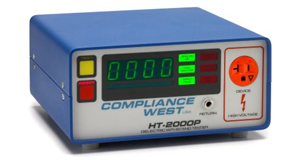AC Leakage Current Determination
The Problem:
Some standards or companies rely on AC hipot testing over DC hipot testing. This can cause a problem if there are motors, capacitors, or other components with a connection between live conductors and ground. Depending on the capacitance of the connection, leakage current can be developed during the hipot test that can possibly overcome the capabilities of the hipot tester, causing a false failure indication.
 This is due to the AC waveform, which goes from a positive peak voltage to a negative peak voltage and back again 60 times a second. This change in voltage causes the capacitance to charge, discharge and charge again for each peak value. This charging takes current, and it is called leakage current. The current is developed by the hipot tester, and if the leakage current is too large, the hipot tester may be asked to develop current which is more than it is set to deliver. The hipot tester interprets this leakage current as a failure, stops the test, and lights the FAIL light. However, there may not be anything wrong with the EUT.
This is due to the AC waveform, which goes from a positive peak voltage to a negative peak voltage and back again 60 times a second. This change in voltage causes the capacitance to charge, discharge and charge again for each peak value. This charging takes current, and it is called leakage current. The current is developed by the hipot tester, and if the leakage current is too large, the hipot tester may be asked to develop current which is more than it is set to deliver. The hipot tester interprets this leakage current as a failure, stops the test, and lights the FAIL light. However, there may not be anything wrong with the EUT.
Determining the leakage current of the EUT
You can determine the expected leakage current of the EUT by measuring the capacitance and applying a formula as noted below. This will give you a rough idea of whether the hipot tester you are using is capable of performing the test.
Measure the capacitance: You are only concerned with the primary capacitance to ground, so you may be able to make this determination from the AC power plug of the EUT. Make sure all primary switches are closed, and short the hot and neutral wires together. Using a DMM, measure the capacitance between the hot and neutral wires shorted together, and the ground of the EUT. (After you obtain the measurement, be sure to remove the short.)
Using the formula I = 377VC, find the leakage current I (in amps) by multiplying the voltage that your hipot test is conducted at (V) by the capacitance you measured between line and ground (C), and multiplying that product by 377. This will give you the anticipated leakage current I (in amps).
Check the specifications of the hipot tester you are using to see if it can deliver this current. If not, you will probably need to find a higher capacity tester. If so, the suggestions in the next section may help.
The Solution:
The leakage current limit of the tester may not be set to the maximum. You may be able to increase the leakage limit trip point.
The ramp time may be set too fast. The problem is magnified during the ramping portion of the test, where the hipot tester is raising the voltage from 0 to the testing voltage. Try slowing down this ramp time to see if that reduces or eliminates the false failures.
Source: Compliance West USA
